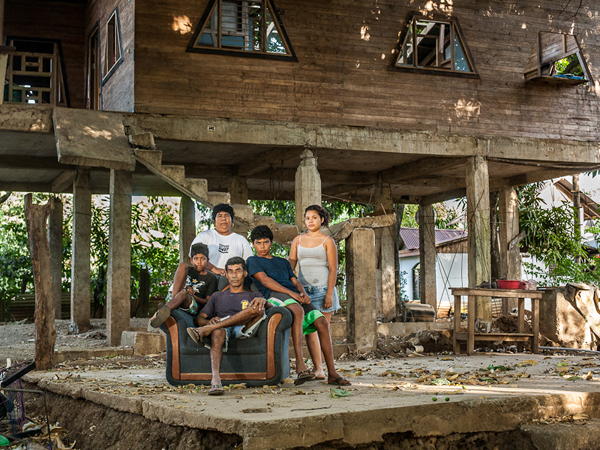
Photo by Giordano Ciampini
Jose “Cholo” Matarrita Cabalceta and Marielos “Chola” Espinoza Matarrita built their house five years ago. Since then, they have lived there with their three children, Joselyn, 20, Justin, 14 and Jafed, 9. According to Joselyn, they built their house with a lot of love with the help of her grandfather and her uncle. Before the earthquake, the family was in the process of completing the finishing touches of the construction.
“It was the only house I’ve had,” lamented Maritza Villareal, resident of Nosara. “I just hope to rebuild it in a better place because we don’t want to live in this little shack with four people. I want to give my kids a better life. We need help and all that we hear from the government is no, no, no,” she explained.
Many families whose homes were damaged in the earthquake of September 5, 2012 are in the same situation: frustrated that they can’t rebuild either their homes or their normal lives. For these families, the earthquake isn’t over yet because five months after losing their homes and belongings, they feel like the help they’ve received from the government is scanty and, as they say, they are “making do” with what they can, such as assistance received from family, neighbors, friends and individual donations.
The home of the Sequeira Villareal family, with four members, completely collapsed and they still haven’t received government support, because according to Maritza they were told that their property, which is in her name, doesn’t qualify to obtain a housing bonus.
“We’ve made efforts at the municipality and we’ve requested a bonus through the Costa Rica-Canada Foundation but they tell us we don’t qualify for the bonus because in the winter water comes into the property,” she asserted.
She commented that the Instituto Mixto de Ayuda Social (IMAS—Mixed Institute of Social Assistance) helped them until November with the rent payment for the house where they were living temporarily; however the help ended, so in December they had to find another place to live and pay rent with their own resources.
If it weren’t for the economic help they have received of two bags of groceries, one from the collection taken up by the Hotel Lagarta Lodge and the other from an individual, as well as $250 from the Nosara hardware store and another $250 from the dinner fundraiser held at Rancho Tico restaurant, they don’t know what would have become of them.
The same story is repeated by various families, for whom the help, which up until now has been a drop in the bucket, comes from everywhere else but the government.
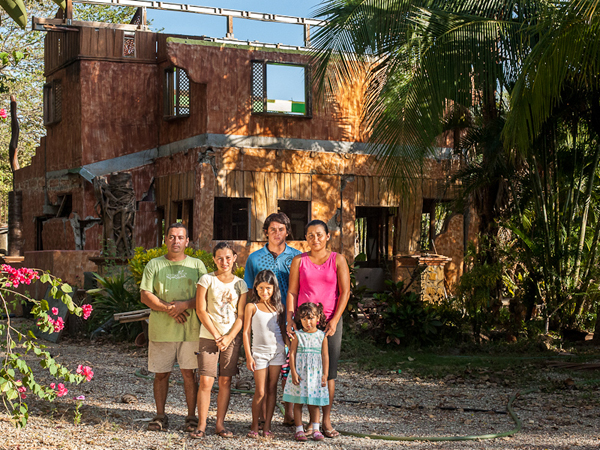
Photo by Giordano Ciampini
Alvaro Avila Alvarado and Anabel Gutierrez Espinoza have lived in this house for ten years, and their two youngest children, Ani Sirena and Eyla Estrella were both born here. “I’m a little sad because there’s a lot of memories there,” said Anabel. “I’m sad that our story with this place has now ended, it’s only memories now that are important for us... only memories.”
Seeking Help from Institutions
According to Luis Diego Moya, an official of IMAS, the institution has tried to help the people most in need in the shortest period possible.
“The social assistance that IMAS gives depends on the area and the type of family,” he assured. “The evaluation that we do is based on each family and their circumstances, number of family members, area where they live and combined income to determine the help that they are going to receive,” he added.
Moya explained that the minimum help that IMAS grants is three months and that before this time elapses, interested parties should go to the closest regional office to continue receiving help. In addition, he indicated that the amount includes the total rent payment during the following months but clarified that this assistance is valid until August of this year.
In the case of the Ministerio de Vivienda y Asentamientos Humanos (MIVAH— Ministry of Housing and Human Settlements), the assistance provided to those who have completely lost their homes or should move and build in another place is the granting of funds for the construction of a new house by means of the Family Housing Bonus. According to the MIVAH press office, 13 billion colones ($26 million) was budgeted for the Family Housing Bonus Program of the Banco Hipotecario de la Vivienda (BANHVI– Housing Lending Bank) to assist the families.
To request support by this route, people who appear on the Affected Families Report should go to one of the financial entities authorized by BANHVI to process the bonus and indicate that they were affected by the emergency.
In the case of Guanacaste, the only entity authorized to process the bonus is Grupo Mutual Alajuela-La Vivienda (Alajuela Mutual Group-Housing), which has offices in Cañas, Liberia and Santa Cruz. So to apply for the bonus, Nicoyans should travel to the agency in Santa Cruz, located on the south side of the Catholic Church.
Ivannia Salas, official of the press department, clarified that Law 7052 permits a person to apply for a second bonus if they lost the first one due to a natural disaster. Nonetheless the second bonus for which they would apply has an economic limit, the same as the ordinary bonus, which currently is 5,950,000 colones ($11,900).
According to MIVAH, taking into account that the person has already acquired the lot, the amount of the bonus should be enough to build a 52-square-meter house, which would have two bedrooms, a living-dining area, kitchen, one bathroom and a sink area in the rear. According to data from MIVAH, between September and the 23rd of January, just in the canton of Nicoya, 103 housing bonuses have been processed, for a total of 586.081.000 colones ($1,172,162).
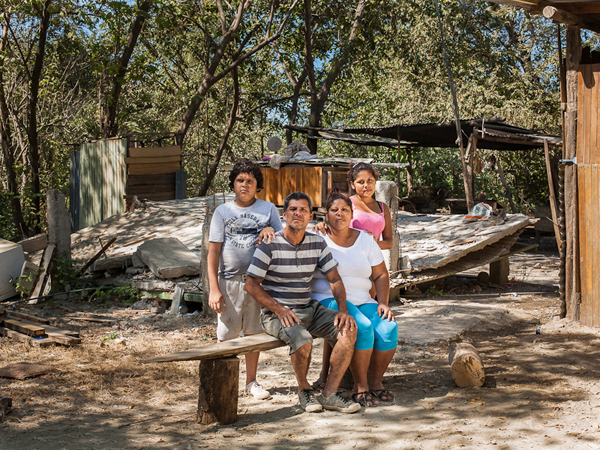
Photo by Giordano Ciampini
Maritza Villareal Sanabre and Uilberth Sequeira Mejia built this house four years before it fell. “It was the only house I’ve had,” said Maritza. “I hope that I can just rebuild, in a better place because we don’t want to live in this little shack with four people. I want to offer my kids a better life. We need help, and all we hear from the government is ‘no, no, no.’”
Municipality Awaits Approval from Comptroller
For its part, the Municipality of Nicoya assured that they already requested 568 million colones ($1,136,000) to give to those who need to repair their houses. The funds are in the municipal coffers awaiting the thumbs up of the Comptroller for implementation.
Adriana Rodriguez, vice mayor and coordinator of the Municipal Emergencies Commission, explained that the amount was included in the extraordinary budget that was sent to the Comptroller’s Office on January 20 and they are awaiting approval to distribute it. “Up until now, we have evaluated more than 700 houses and we’ve communicated to the people that they should come to the municipality to get the respective construction permits so that when we have the approval from the Comptroller, they already have these procedures completed,” she affirmed.
Rodriguez explained that resources will be assigned first to those who most need them since their housing condition is grave.
Meanwhile, families like Freddy Brenes and Jennifer Ramirez still haven’t lost hope of recovering their home. They live in San Pedro of Nosara and their house suffered internal and external structural damage, which allows one wall to move freely, increasing the risk that the house could collapse at any time. “I sincerely hope to be able to rebuild our home with God’s help,” said Jennifer. “This ray of hope is all that I have.”
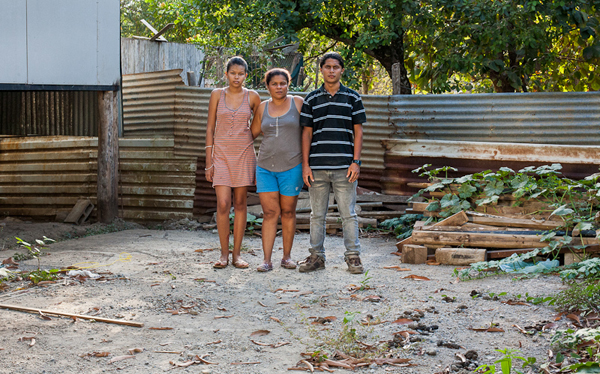
Photo by Giordano Ciampini
“The house was 5 years old,” said Damaris Matarrita Matarrita. “And in just a little time we lost everything that we worked for to build that house.” Damaris says that she paid off her 5,000,000 colones investment in December 2011, and nine months later the house was completely destroyed. “My son struggled with me, working at Harmony Hotel to help me pay off the house, and now it’s lost.”
 |
- Espinoza-Matarrita Family – Familia Espinoza-Matarrita Image 1
Family members: Jose “Cholo” Matarrita Cabalceta, 45; Marielos “Chola” Espinoza Matarrita, 43; Joselyn Espinoza-Matarrita, 20; Justin Espinoza-Matarrita, 14; Jafed Espinoza-Matarrita, 9
Support Received:
2 grocery bags, one from Lagarta Lodge and one from the Emergencies Commission
$500 materials from Nosara hardware store
$200 from Rancho Tico dinner
$36 from Escuelita Americano and local donations
- Avila-Gutierrez Family/ Familia Ávila - Gutiérrez – Image 2
Family members: Álvaro Ávila Alvarado, 41; Annabel Gutiérrez Espinoza, 37; Álvaro Adrián Ávila Gutiérrez, 17; Duña María Ávila Gutiérrez, 15; Ani Sirena Ávila Gutiérrez, 8; Eyla Estrella Ávila Gutiérrez, 4
Support Received:
3 months of $240 for home rental
1 bag of groceries from a fundraiser with a value of about $40
$560 from Rancho Tico dinner
$500 from the Nosara hardware store
- Sequeira-Villareal Family – Familia Sequira-Villarreal Image 3
Family members: Uilberth Sequeira Mejia, 50; Maritza Villareal Sanabre, 32; Yailin Villareal Sanabre, 16; Andres Sequera Villareal, 10
Support Received:
2 bags of groceries, one from Lagarta Lodge breakfast fundraiser and the other from an unknown source
$250 from the Nosara hardware store
$250 from Rancho Tico dinner
- Matarrita-Matarrita Family – Familia Matarrita-Matarrita Image 4
Family members: Damaris Matarrita Matarrita, 46; Manfred Matarrita Matarrita, 26; Andrea Matarrita Matarrita, 15
Support Received:
A washing machine donated by an individual
Machinery lent to clear the rubble from tearing down remains of the house
$550 from the Rancho Tico dinner
$500 in construction materials from Ferreteria Nosara
- Baltodano-Juarez Family – Familia Baltodano-Juarez Image 5
Family members: Santo Baltodano Obando, 73; Marta Juárez Juárez, 70; Sandra Baltodano Juárez, 41; Sandy Bermúdez Baltodano, 23; Francinny Alfaro Baltodano, 22; Jaime Alfaro Baltodano, 14; Franceska Alfaro Baltodano, 6; Brandon Alfaro Baltodano, 5; Mariangel Alfaro Baltodano, 2 meses/2 months
Support Received:
1 grocery bag from Nosara Development Association
Enrique Vega donated machinery to help clear rubble
$500 construction materials from Nosara hardware store
$500 from Rancho Tico dinner
$500 from an individual
$240 construction materials from Surfing Nosara
- Brenes-Ramírez Family – Image 6
Family members: Freddy Brenes Chávez, 43; Yennifer Ramírez Arce, 35; Dayana Brenes Ramírez, 13; José Ignacio Brenes Ramírez, 6
Support Received:
$500 in materials from Nosara hardware store
$250 from Ranco Tico dinner
$260 from Cafe de Paris
Promised funds from Surfing Nosara |
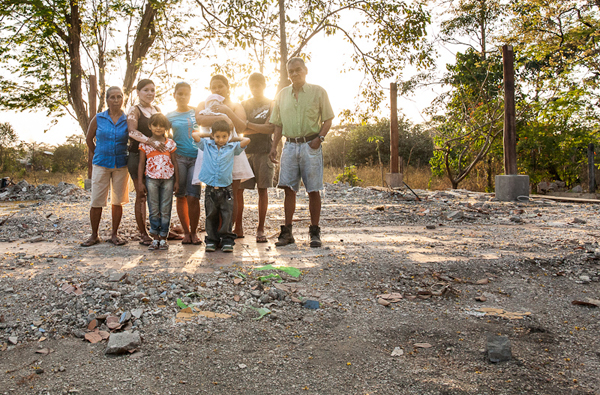
Photo by Giordano Ciampini
Sandra Baltodano Juarez lived in this home for ten years with 8 other family members before the earthquake. “Really, I practically designed the house,” she said. “We didn’t have money to pay the engineer to do it, so everything from the balcony to the bathrooms was my design. We worked hard with my cousins, my dad, and other family members lay down the wood floor and put up the gypsum to make the walls.” The latest addition to the family, Mariangel, was born after this home was damaged by the quake, and Sandra believes that her birth symbolizes a new generation for a new place.
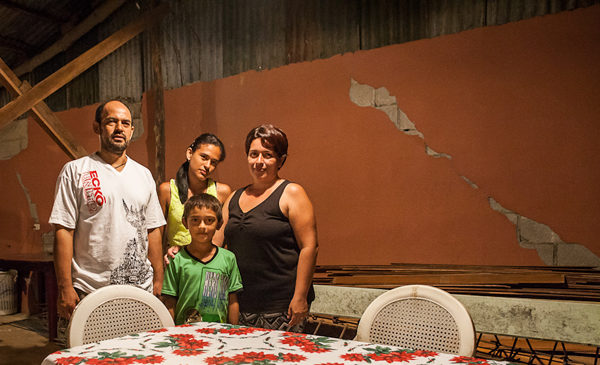
Photo by Giordano Ciampini
Although Jennifer Ramirez Arce, Freddy Brenes Chaves and their family have only lived in the house for four years, Jennifer says it’s “the only home we have; it’s our kids’ home.” The house suffered few external damages, but internally there are foundational cracks and a loss of a structural support which allows one wall to move freely, risking total collapse. “I sincerely hope to God that I can rebuild our home,” said Jennifer. “That light of hope is all I have left.”
|
| |
More Regional News
“The Minister of Agriculture Doesn’t Know Anything about Transgenics,” Legislator Claudio Monge Pereira
Indignant and upset, Claudio Monge Pereira, legislator of the Citizen Action Party, declared that Gloria Abraham, Minister of Agriculture and Livestock, doesn’t know about Genetically Modified Organisms (GMOs).
President of CR’s Commission on Human Rights proposes doctor visits to “cure gays”
The president of Costa Rica’s Commission on Human Rights, Justo Orozco, wants the Spanish doctor Jokin de Irala to present his “homosexuality as a disorder” ideas with Congress.
New Director Found Nicoya’s Hospital Functioning at 60%
The new director of the La Anexion Hospital of Nicoya, Dr. Jorge Fonseca Renault, conversed in depth with VON a month after taking the reins of the main medical campus of the peninsula, after the Costa Rican Social Security Fund (CCSS) intervened in December due to serious management deficiencies.
New Foundation Looks to Install Security Cameras in Nicoya, Samara and Nosara
The new nonprofit Fundacion Para la Seguridad Integral de Nicoya (Foundation for the Integral Security of Nicoya), which was registered in December 2012, has the goal of raising funds to install security cameras strategically placed around Nicoya canton.
Earthquake Damages Won’t Stop Students From Going Back to School
Due to the serious damages to educational centers caused by the earthquake on September 5th, many students ended 2012 with classes being held in alternate sites and the new semester, which starts on February 6, will begin and end the same way for at least 19 school grounds in the region of Nicoya, where students will receive classes in shared classrooms, halls, churches and rented buildings.
Pictures and News of the Month
The Voice of Nosara brings you a brief recap of January stories you might have missed.
|
 |
|
 |
| |
|
 |
|
|

